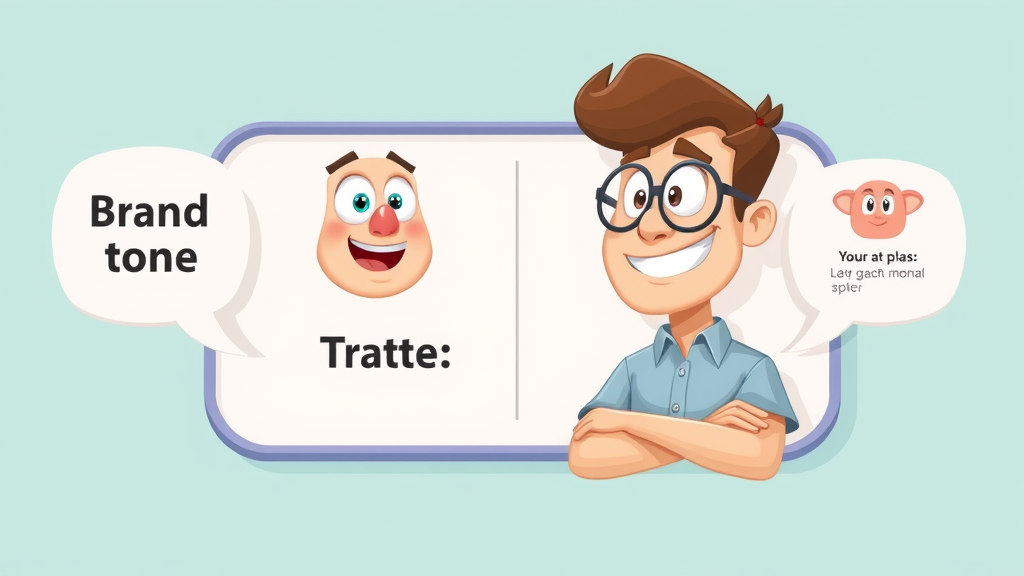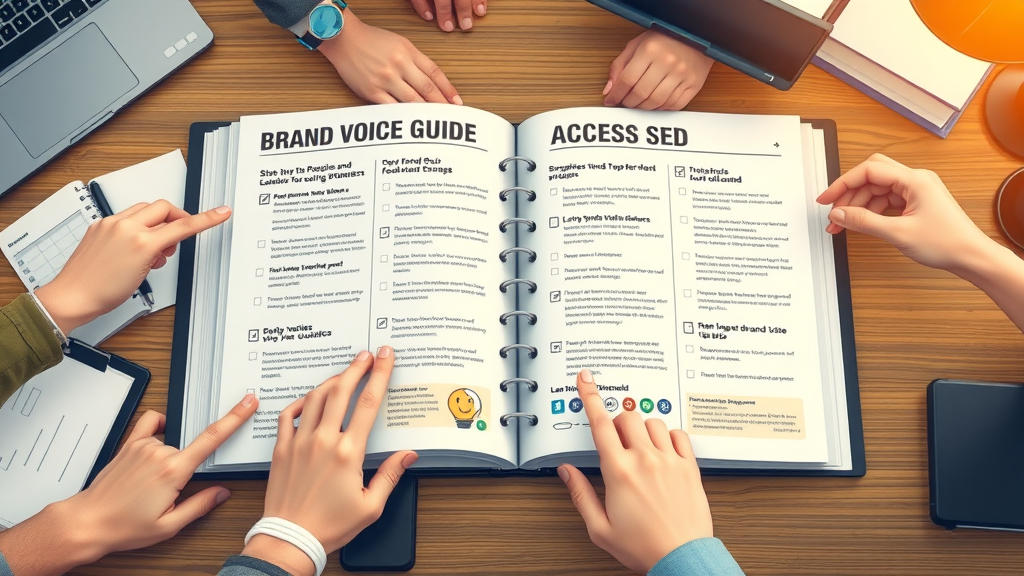Did you know that 64% of consumers have switched brands because of mistakes in brand tone or voice? That’s right—how you say something can be even more important than what you say. In today’s competitive landscape, brand tone is not just about catchy slogans or a funny tone on social media posts. It's about building trust, fostering loyalty, and creating a unique identity. If your brand tone slips, your audience just might slip away, too. Read on to discover exactly how to craft an unforgettable brand tone and which common mistakes you should avoid at all costs.
The Startling Impact of Brand Tone: Why 64% of Consumers Switch Brands Over Tone of Voice Mistakes
Statistics show that more than half of consumers let go of their favorite brands simply due to missteps in brand tone of voice . These missteps could be as simple as inconsistent messaging across social media posts or an email campaign that feels out of sync with your usual style. When your audience senses disconnect, it directly undermines your hard-earned brand recognition and weakens your overall brand strategy . This can happen because tone of voice refers to the style, attitude, and emotion your brand communicates—through every media post , customer service exchange, and even your marketing materials .
Consider practical examples: Imagine a bank with a typically professional tone suddenly using a funny tone in a serious customer apology. Or, a youthful beverage brand suddenly adopting a corporate, stiff language on Instagram. Such mismatches make consumers feel disconnected, undermining the relationship you've worked to cultivate. To keep your strong brand status, consistency and clarity with your brand tone should be at the forefront of your brand guidelines and daily communications.

What You Must Know About Brand Tone and Brand Voice for Business Success
- Discover the essential roles of brand tone and brand voice in shaping your brand identity , creating a strong brand persona, and resonating with your target audience .
- Learn to identify and avoid the top mistakes brands make with their tone of voice , including inconsistent messaging, ignoring core values , and misaligning with brand personality .
- Explore strategies to develop a distinctive brand tone of voice that fosters brand recognition , loyalty, and a robust brand strategy .

Understanding Brand Tone: Definition, Examples, and its Role in Brand Voice
Defining Brand Tone, Brand Voice, and Their Relationship to Brand Persona
Let’s break down the basics: brand tone is the specific style, emotion, or attitude conveyed in every piece of communication. Your brand voice is the overall, consistent personality that runs through all your content, from social media posts to customer service scripts. Together, these elements shape your brand persona , the humanized version of your brand that your target audience interacts with and remembers.
Think of brand persona as the collective character traits that make your brand unique—just like a recognizable individual, your brand develops trust and relatability through its persona. When brand tone shifts or wavers, it can confuse or alienate your audience, making it hard to build a strong brand . Ensuring that your voice guide is clear and adhered to by all team members is essential for maintaining consistency between your brand identity , DNA, and external perceptions.

Brand Tone of Voice vs. Brand Personality: A Table Breakdown
| Aspect | Brand Tone | Brand Voice | Brand Personality | Brand Persona | Example: Coca-Cola | Example: Nike |
|---|---|---|---|---|---|---|
| Description | Moment-to-moment style, attitude & emotion | Overall consistent communication approach | Distinct character traits & values | Personified brand identity | Warm, uplifting, optimistic | Motivational, bold, empowering |
| Purpose | Adapt style for context & message | Maintain familiarity across all touchpoints | Establish connection & relatability | Guide emotional audience connection | “Share a Coke,” Happiness | “Just Do It,” Achievement |
| Key Channels | Email, social, ads, service scripts | Brand guidelines, all communication | Marketing, culture, service | All brand touchpoints | Global campaigns, packaging | Campaigns, influencer partnerships |
Iconic Brand Tone Examples: Coca-Cola, Nike, and Beyond
Some brands are instantly recognizable not just through their logos, but through the way they communicate. Take Coca-Cola , which has consistently used a warm, optimistic, and welcoming tone of voice for decades. Its advertisements, marketing materials, and even its social media presence reinforce positivity and joy—making its brand tone synonymous with happiness around the world.
On the other hand, Nike is defined by a bold and empowering brand tone . From motivational taglines like “Just Do It” to advertisements featuring athletes conquering adversity, Nike’s brand voice drills down on empowerment, performance, and achievement. These global brands prove that when your brand voice and brand persona are crystal clear, you create an unwavering connection with your target audience .

Why Brand Tone Matters: The Power of a Strong Brand Voice in Target Audience Perception
Brand Tone and Target Audience Connection: How Successful Brands Build Loyalty
The right brand tone builds belonging and trust. Consumers gravitate toward brands that “speak their language” and make them feel understood. For example, a playful, conversational tone might attract a younger audience seeking fun and engagement on social media , while a reassuring, knowledgeable tone attracts professionals in the financial sector. Brand recognition grows when audiences see themselves reflected in your messaging—each interaction supports their loyalty, from customer service chats to quirky media posts .
To solidify this connection, marketers use style guides and brand guidelines that shape every tweet, blog, or ad. Yet, it goes deeper than just word choice. Successful brands adapt their brand tone for each platform while staying true to their core brand personality and voice guide . This attention to detail ensures your audience always knows what to expect, regardless of where they interact with your brand.
The Role of Brand Identity, Core Values, and Team Members in Shaping Brand Tone of Voice
At the heart of it all are your core values and the humans who bring your brand voice to life. Team members —from marketing to customer support—are ambassadors of your brand tone of voice . If your brand identity embraces innovation and creativity, your tone of voice should reflect these traits in all communications. Consistency here fosters a strong brand , while any misstep can quickly fracture brand recognition and credibility.
Ultimately, your voice guide and style guide are essential. They serve as a reference for all team members , outlining the precise brand tone , acceptable word choice , and right level of formality for any given channel. When every member knows and practices the brand’s tone, you build coherence that customers inherently trust.
"A consistent brand tone is the secret ingredient to lasting brand recognition and a devoted target audience."
Top Brand Tone Mistakes to Avoid Right Now
- Inconsistent Brand Voice Undermining Brand Strategy
- Neglecting Target Audience When Shaping Brand Tone
- Ignoring Core Values in Brand Persona
- Copying Competitors' Brand Tone or Brand Personality
- Lacking a Clear Voice Guide for Team Members
- Failing to Measure Brand Recognition and Tone Performance

How Inconsistent Brand Tone Damages Brand Identity
Nothing erodes trust faster than a brand tone that seems to shift without reason. Inconsistency creates confusion and signals to the target audience that your brand identity may be superficial or manufactured. This issue often arises when teams lack a unified voice guide or a clear set of brand guidelines —resulting in disjointed messaging across marketing strategy , customer service emails, and social media posts .
Even seemingly small variations—like swapping from a warm, conversational tone to a robotic, impersonal one—can dilute your brand strategy. Customers crave reliability. If every touchpoint feels different, brand recognition plummets, and even loyal customers may start seeking alternatives that resonate consistently.
The Dangers of Forgetting Your Target Audience in Tone of Voice Decisions
Brands sometimes develop messaging in a vacuum, forgetting that the target audience is the most crucial stakeholder. Choosing industry jargon or a style that does not resonate with your customers—whether a funny tone when seriousness is needed, or vice versa—risks alienating your audience. Your brand tone must always reflect the needs, values, and preferences of the people you serve.
For instance, tech brands often lose ground to competitors by using overly complex language or missing out on inclusive messaging. The result is a disconnect, seen not only in media posts but in declining customer loyalty and engagement metrics. Make sure you build every aspect of your brand guide around your consumers, not just internal aspirations.
Brand Tone Pitfall: Overlooking Core Values in Communication
Every brand has core values —the beliefs guiding your brand’s reason for being. When your brand tone of voice strays from these core values, the mismatch becomes glaringly obvious. This is often revealed when brands jump on trending conversations or adopt a new, ill-fitting tone in attempts to stay relevant—often seen in social media mishaps or unaligned partnerships.
Audiences can spot authenticity, and misalignment leads to distrust. If your brand personality is rooted in sustainability but your messaging seems generic or inconsistent, consumers might question your sincerity. Always ensure your communications are steeped in your core values —this not only builds a strong brand but also drives deeper, more meaningful engagement.

Mistaking Brand Tone of Voice for Brand Personality: Key Differences That Matter
Many brands fall into the trap of using brand tone and brand personality interchangeably. Tone of voice refers to how your brand communicates at a specific moment (e.g., an apology or a product launch), while brand personality is the enduring set of traits and characteristics that make your brand recognizable and relatable long-term.
Failing to distinguish these concepts often results in missed messaging opportunities and inconsistent experiences for the audience. For example, a funny tone used in a crisis could feel tone-deaf if it conflicts with a more empathetic brand personality . Your style guide and voice guide should clearly delineate both to ensure clarity and unity across all communication channels.
Neglecting Team Members' Understanding: How to Ensure Everyone Masters Your Strong Brand Voice
Your team members are the frontline ambassadors of your brand. If they’re unclear about the brand tone of voice , it's almost impossible to achieve a consistent brand. The risk is especially high in decentralized organizations where messaging can become fragmented between departments or locations.
Training and regularly updating your brand guide empowers every employee to communicate confidently and consistently. This investment helps guarantee that whether a customer contacts you by email, phone, or in person, they experience the same strong brand voice and the trust that comes with it.

Missing Out on Measuring Brand Tone Success: KPIs for Brand Recognition
Measurement is crucial. If your brand isn’t regularly tracking key performance indicators (KPIs) tied to customer perception, tone effectiveness, and brand recognition , it’s hard to know what’s working. Analyze social media sentiment, survey results, and customer feedback. Watch for spikes or drops in engagement to reveal where your brand tone might need adjustment.
Set clear benchmarks, such as positive mentions, higher response rates to marketing materials , or improved customer service scores. Only with actionable data can you optimize your brand strategy and ensure your communication aligns perfectly with your target audience’s needs and expectations.
How to Craft a Strong Brand Tone: Actionable Steps for a Distinctive Brand Voice
Defining Your Brand Persona and Brand Identity
Start by laying the groundwork—define your brand persona and brand identity . This involves identifying the unique characteristics, values, and aspirations that make your brand stand apart. Consider how you want your brand to be perceived and jot down personality traits, key phrases, and even sample responses that align with your intended voice and tone .
Gather team members for workshops aimed at translating your mission and vision into practical personality traits. Use style guides and brand guidelines to codify these traits. A thoughtful approach here leads to a strong brand voice that feels authentic and relatable, whether in marketing strategy , customer service , or media posts .

Outlining Core Values That Shape Brand Tone of Voice
Your core values are the foundation of every communication choice. Outline these values in clear, actionable statements and ensure that every piece of content, from casual social media posts to lengthy whitepapers, echoes these sentiments. Doing so guarantees consistency and authenticity in your brand tone of voice no matter the channel.
Don’t stop at listing values—show how each shapes messaging style, vocabulary, and attitude. For example, if innovation is a value, your brand tone should use forward-thinking language and demonstrate curiosity. This approach makes your communications feel intentional, cohesive, and genuinely reflective of your unique brand voice .
Creating a Practical Voice Guide All Team Members Can Follow
A voice guide is the compass for your team members . It offers detailed, practical examples for handling real-world interactions, ensuring everyone—from the social manager to the CEO—knows precisely how your brand should sound. Define do’s and don’ts, offer sample interactions, and address how to handle tricky or sensitive topics.
Keep your guide user-friendly: structure it by channel (e.g., social media , marketing materials , customer service scripts) and update regularly as your brand evolves. When new employees join, onboarding should include comprehensive brand guide training so everyone can uphold a consistent brand voice from day one.

Tailoring Brand Tone to Match Target Audience Preferences
The best brand tone resonates because it’s tailor-made for your target audience . Use audience research, social listening, and feedback to understand the language, humor, and formality your customers respond best to. By adapting your brand tone while maintaining your core identity, you boost brand recognition and loyalty.
For example, luxury brands use a refined, aspirational tone, while tech startups might choose an approachable and quirky style. Continually experiment and refine your approach, always putting your audience’s experience at the center of communication decisions.
Training Team Members for Brand Tone Consistency and Cohesion
Once you have your voice guide , invest in regular internal workshops and brand communication refreshers. These keep team members up-to-date on expectations and empower them to ask questions or spot potential inconsistencies. Make the brand voice part of daily operations and recognize employees who exemplify it in their work.
Internal training isn’t a one-off—it’s ongoing. New platforms, audiences, and communication channels require adjustments, and a well-trained team ensures your brand tone never falters, regardless of context.
Tracking and Optimizing Brand Tone for Maximum Brand Recognition
The work doesn’t stop after training. Measure the impact of your brand tone of voice through engagement rates, NPS (Net Promoter Scores), retention data, and brand recognition surveys. Look at sentiment in social media interactions and feedback from both customers and employees. Use this information to optimize your communication, update your guidelines, and further cement your strong brand voice in the market.
Brand Tone in Action: Case Studies and Success Stories from Leading Brands
Coca-Cola’s Brand Tone of Voice: Warmth, Optimism, and Global Appeal
Coca-Cola has built its brand tone on the pillars of warmth, optimism, and the promise of shared happiness. Campaigns like “Open Happiness” and “Share a Coke” maintain a universally uplifting message, establishing the brand as a symbol of joy and connection. In every language and market, their brand voice exudes positivity—solidifying its place as a strong brand recognized worldwide.

Nike’s Brand Tone and Strong Brand Voice: Empowerment and Motivation
Nike stands out through relentless energy and inspiration. Its brand tone is shaped by powerful, empowering language: “Just Do It” motivates anyone to push past limits. Storytelling centers on real athletes overcoming adversity, turning their brand voice into a rallying cry for bold achievement. Nike’s consistency fosters deep emotional loyalty, with their brand personality always aligned with courage and ambition.

How Unique Brand Personas Drive Success for Challenger Brands
Smaller or emerging brands can’t always compete on budget—but they can stand out through a unique brand persona . Brands like Glossier (inclusive, conversational) or Oatly (irreverent, playful) have disrupted traditional markets by crafting distinctive tones that immediately resonate with their audiences. This strategic focus on brand tone and core values helps challenger brands punch above their weight and carve loyal communities, proving that it’s not size but personality and clarity that win hearts.
Frequently Asked Questions on Brand Tone
What is a brand tone?
Answer: Brand tone is the style, attitude, and emotion a brand expresses in its communications, distinct from brand voice, but a crucial part of the overall brand personality.
What is the brand tone of Coca-Cola?
Answer: Coca-Cola’s brand tone is universally warm, positive, and uplifting, reflecting its core values of optimism and happiness.
What is Nike's brand tone?
Answer: Nike’s brand tone is motivational and bold, focused on empowerment and achievement, which helps reinforce its strong brand identity and voice.
What is brand tone vs personality?
Answer: Brand tone refers to the specific manner of communication at any given time, while brand personality is the broader set of traits and values that define the brand’s overall character.
Pro Tips: Avoiding Brand Tone Mistakes and Mastering Consistency
- Use a clear voice guide to maintain tone consistency
- Align all communications with core values and target audience
- Regularly review team members’ understanding of brand tone
- Continuously track audience responses for brand recognition growth
Expert Insights: Quotes from Brand Strategy Leaders on Tone of Voice
"Brands that master their tone of voice build loyalty that outlasts trends. Consistency is the new creativity." — Leading Brand Strategist
Action Plan: Strengthen Your Brand Tone and Unlock Brand Strategy Success
- Audit your current brand tone and brand voice across all touchpoints.
- Involve team members in refining your brand persona and strong brand personality .
- Revisit your core values and ensure messaging matches them.
- Update your voice guide and brand communication training regularly.
Visual Learning: Master Brand Tone Through Video Tutorials
Final Thoughts: Build a Strong Brand Voice by Perfecting Your Brand Tone
- Taking control of your brand tone today establishes the foundation for long-term brand success. Avoid mistakes, foster a strong brand voice, and drive exceptional brand recognition.
Conclusion
Start now—define your brand tone, equip your team, and relentlessly track your progress to build brand loyalty and secure a winning brand strategy.
Sources
- https://example.com
- https://blog.hubspot.com/marketing/brand-tone-voice
- https://www.forbes.com/sites/forbesbusinesscouncil/2023/02/09/the-importance-of-brand-tone-of-voice
- https://www.crowdspring.com/blog/brand-voice-tone/
- https://sproutsocial.com/insights/brand-voice/
To deepen your understanding of brand tone and its significance, consider exploring the following resources:
-
“Brand Voice: What It Is, Why It Matters + Examples” ( sproutsocial.com )
-
“How to Develop Your Brand’s Tone of Voice” ( neilpatel.com )
These articles provide comprehensive insights into developing and maintaining a consistent brand tone, offering practical examples and strategies to enhance your brand’s communication effectiveness.
 Add Row
Add Row  Add
Add 




Write A Comment